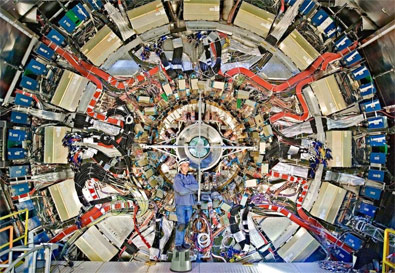Improving the world's largest digital cameras
The innermost detectors on the ATLAS and CMS projects are rather like gigantic digital cameras. Each houses around 80 million pixels close to the beam line and 6 million elongate rectangular pixels (strips) further out to deliver an incredibly detailed and crisp snapshot of the collisions occurring at their centres. But with ten times more collisions expected in each detector when the LHC is upgraded, even all those million pixels won't be enough to photograph the resulting fireworks.
"It's an exaggeration, but you could almost imagine that with so many collisions all the pixels would light up at the same time," says Marc Weber at the Rutherford Appleton Laboratory. "We will need more pixels to see the collisions in detail."
But even cramming almost hundred million pixels into the inner detectors was difficult – bumping that total up to at least 400 million needed for the upgraded detector will require some ingenious design work.
Each pixel is powered, and so in theory over four times as many more power cords must be threaded through the detector. But using more of the same relatively thick cables as are in the detector at the moment is not an option (see figure, right). There is simply no room for more cables. In addition "we want to have pixel modules in that space, not cables," Weber says. “If there is lots of cable mass around each pixel module, it can deflect the particles from the collisions,” says Weber. “Then we would measure those distortions rather than the original trajectories.”
Two solutions
One way to save space is to increase the voltage running through the cables – a trick that has been used by scientists for well over a century. The power running through a cable is related to both the voltage and the current. It’s possible to send the same amount of power through a cable by increasing the voltage and simultaneously lowering the current.
The advantage is that cable diameter is proportional to current, and so the high voltage cables can be thinner. When the cable reaches the pixel modules, a simple converter can step down the voltage and increase the current to the levels needed for the module.
Another approach is to completely change the way the pixels are powered. At the moment, each is fed by its own power supply. But for the SLHC, a few cables could each power a large number of pixels. "It's like the electric lights on a Christmas tree," Weber says. "Using that approach we could reduce the number of cables we need by a factor of almost twenty."
Environmental issues
But both methods carry their own problems. “These are the way things have been done for 100 years,” says Weber. “The reason why have we’ve not used these methods up to now is because of the specialised environment we are working in. It makes using these known ideas difficult.”
Very high magnetic fields pass through the inner detectors of ATLAS and CMS. Those magnetic fields will severely affect the performance of the converters needed to increase the current arriving at each pixel module. “There’s no way around that,” says Weber. “We just have to accept the inductors will perform poorly and adapt the electronics design accordingly."
The other approach – treating the inner detector as a Christmas tree – is not without its problems, as anyone who has struggled to get their Christmas lights working knows. In extreme cases if one light bulb breaks, all the lights go out. "We have to be careful not to fall into that trap," Weber says. "We can add protection circuits around each pixel so if it breaks, the power can go around it."
If the strong magnetic fields in the inner detectors weren’t enough of a problem, there’s another consideration. Increasing by ten times the number of particle collisions in the bowels of the detector will also increase by ten times the amount of damaging radiation. That radiation can destroy the fragile electronics in the detector, which means the pixels and the power management electronics also have to be made radiation proof – commercial electronics would likely stop functioning after only minutes of operation in this hostile environment.
Finding solutions to all of these problems is going to occupy the time of the Work Package 8 team for the next few years.
The ATLAS SCT (semiconductor tracker) detector. The thick red cables on show feed the detector with half of its power - adding more will take up even more space.





